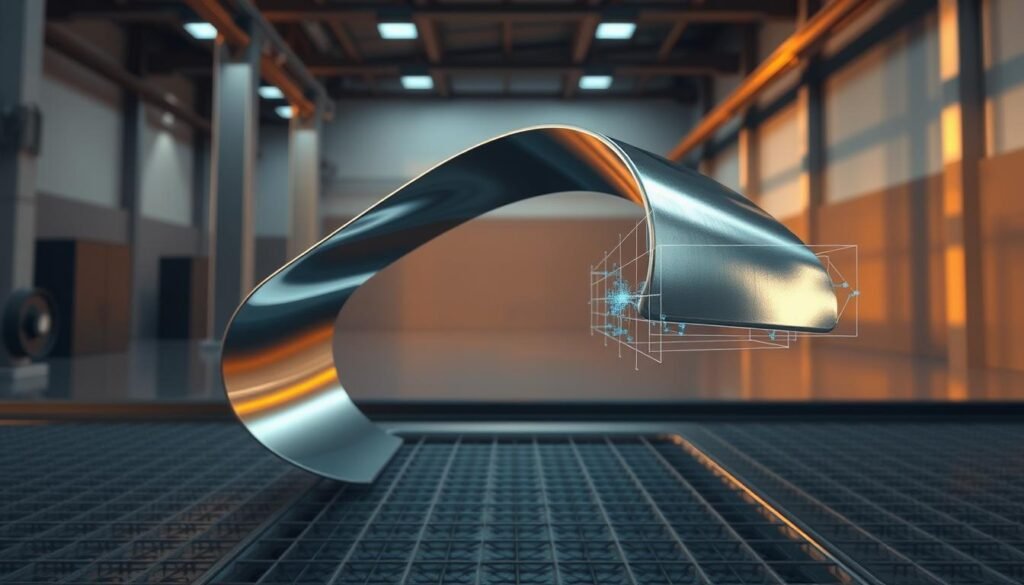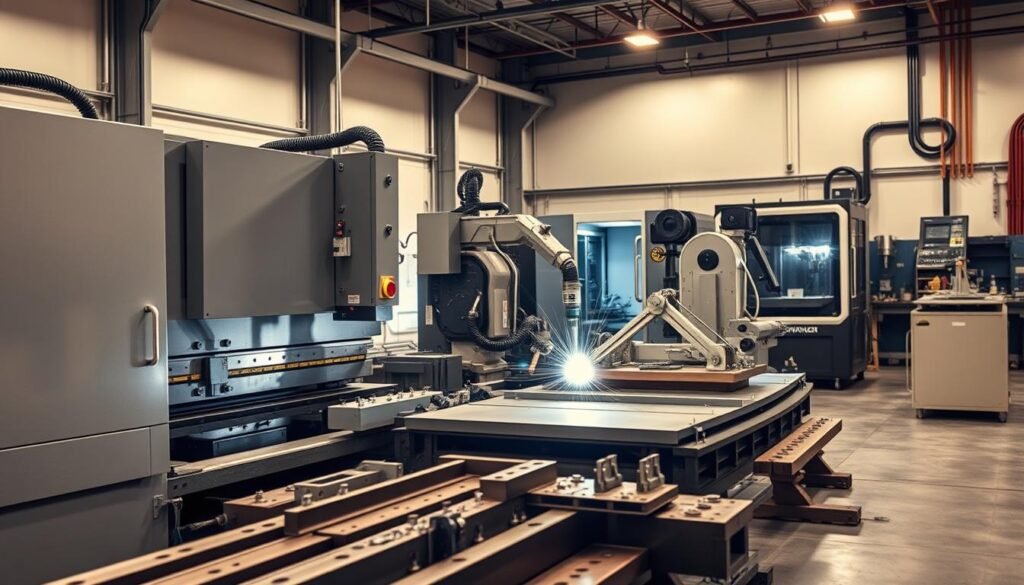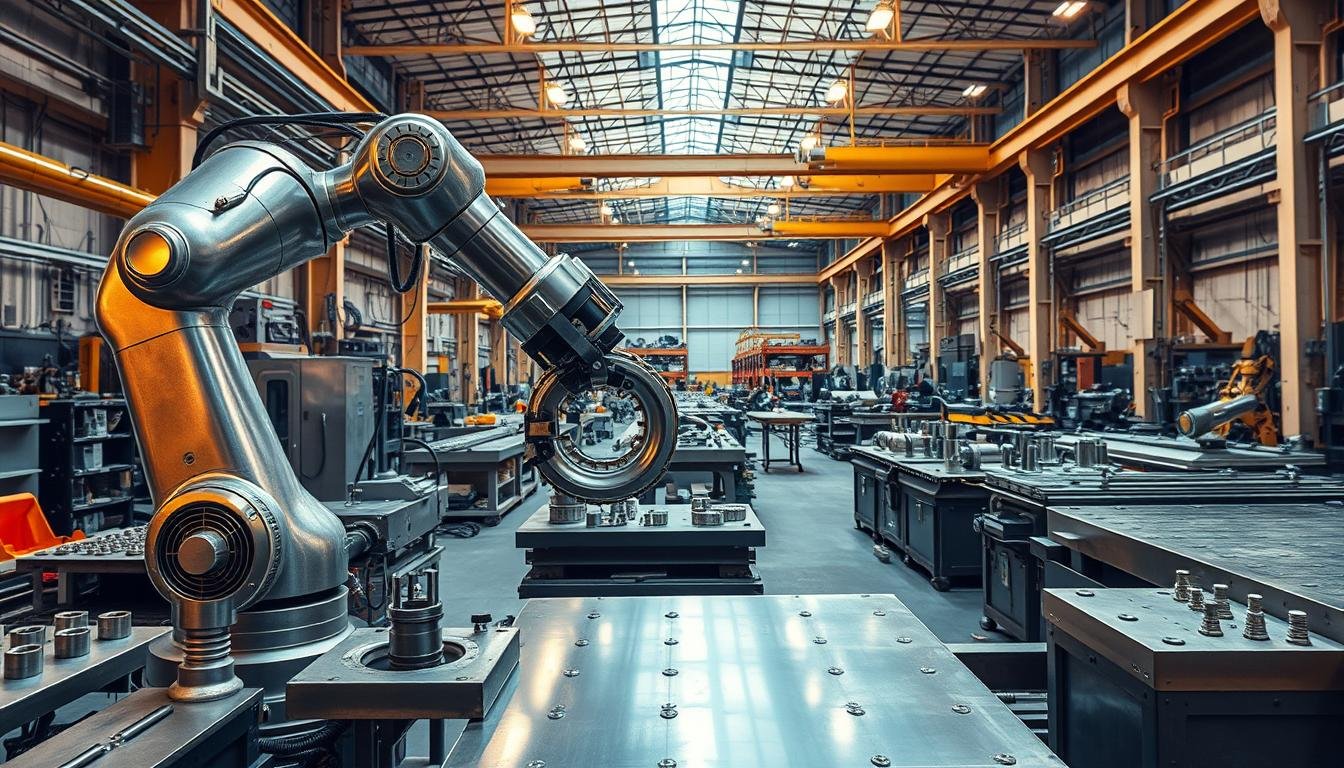In the world of modern manufacturing, new bending techniques have changed the game. Now, making complex shapes with precision is key. This is because industries want products that are both functional and stylish.
By using the latest technology, manufacturers can work more efficiently. This means they can make better products. It also helps them meet their clients’ needs and explore new design possibilities. For more on how these changes affect sheet metal fabrication, check out Mekalite’s resources.
Key Takeaways
- Innovations in bending have changed the dynamics of sheet metal frame fabrication.
- Complex shapes are now easy to achieve with advanced bending techniques.
- Precision manufacturing plays a crucial role in meeting industry demands.
- Improved efficiency leads to better design outcomes in product development.
- Embracing technology is key to pushing the boundaries of metal fabrication.
The Evolution of Sheet Metal Bending Techniques
The history of sheet metal bending is quite interesting. It has changed from simple manual methods to advanced automated systems. This change shows how technology has greatly improved sheet metal fabrication.
Historical Perspective on Bending Processes
At first, bending sheet metal was done by hand. People used tools like hammers and anvils. This was hard work that needed a lot of skill.
This time showed how important human skill was for making things precise and good.
Transformation through Technology Over Time
Later, mechanical press brakes came along. They made things faster and more accurate. This let makers make more complex shapes easily.
Then, hydraulic systems came next. They made things even better, improving how well things could be made.
The biggest change was when CNC technology arrived. It let makers make things with even more precision. Now, we see new tech helping with making things even better.
| Era | Techniques | Key Innovations |
|---|---|---|
| Traditional | Hand tools, skilled labor | Craftsmanship |
| Mechanical | Mechanical press brakes | Increased productivity |
| Hydraulic | Hydraulic bending machines | Enhanced performance |
| CNC | Computer Numerical Control | Precision and complex designs |
Understanding CNC Technology in Sheet Metal Bending
CNC technology is key in modern manufacturing, mainly in sheet metal work. It makes bending automatic, improving accuracy and consistency. This change helps us make complex designs easier than before.
Defining CNC and Its Benefits
CNC uses computers to control machines, like those for bending sheet metal. It’s great for making complex shapes and reducing mistakes. The main benefits are:
- Enhanced Precision: CNC machines can get as precise as 1 micrometer, making parts top-notch.
- Repeatability: Making the same part over and over is easy and consistent.
- Complex Design Capability: The software makes it simple to create complex shapes.
Learn more about CNC technology and its uses.
Impact on Precision and Productivity
Using CNC in sheet metal bending boosts productivity a lot. It cuts down setup and work time, saving costs and increasing output. CNC also lets makers work with many materials, not just metals.
| Feature | Manual Methods | CNC Technology |
|---|---|---|
| Accuracy | Varies, prone to operator error | High precision |
| Setup Time | Longer, involves multiple manual steps | Short, programmable setups |
| Production Volume | Suitable for low volumes | Ideal for both low and high volumes |
| Material Variety | Limited to specific types | Wide range of materials |
CNC technology is crucial in the industry. It sets new standards for sheet metal work and changes how we measure productivity.
Innovations in Digital Bending Simulation

Digital bending simulation has changed the way we make things. It gives us tools that make designs and making things more accurate. With advanced tools, we can see how bending works in detail.
This helps us make changes easily and test if things will work. It’s a big part of making sure our ideas are doable.
Tools for Visualization and Feasibility Testing
Tools like AutoForm and Pam-Stamp are key in the industry. They let engineers see how metal sheets behave under different conditions. This helps spot problems early.
Seeing the bending process helps us choose the right tools and settings. It makes our decisions better, saving time and money.
How Simulations Reduce Material Waste
Using digital bending simulations helps cut down on waste. It lets us find and fix problems before we start making things. This means less waste and fewer mistakes.
It also makes our products better and helps the planet. It’s a win-win for everyone.
Robotics and Automation in Sheet Metal Bending

Robotics in metal bending has changed how we make things. It makes making things faster and better. Machines work all the time, so factories can make things day and night.
This means less time stopped and more things made. Machines can bend metal just right, every time. This is better than when people do it.
Integration of Robotics for Increased Efficiency
Automated machines bend metal fast and well. They can handle many sizes and thicknesses. This lets factories change what they make quickly.
Robots make things faster and cheaper. Workers can focus on harder tasks. This makes everything better.
Enhancements in Quality Control through Automation
Automation has made checking quality better. Robots with smart systems bend metal just right. This is key for things like car parts and medical tools.
Robots check metal parts well. This helps make sure everything is good. It helps make things better and more reliable.
| Feature | Robotics in Metal Bending | Traditional Methods |
|---|---|---|
| Production Rate | Continuous operation with minimal downtime | Dependent on manual labor shifts |
| Precision | High precision with minimal human error | Subject to human variability |
| Cost Efficiency | Reduced labor costs and material waste | Higher labor costs and potential waste |
| Flexibility | Quickly adaptable for various operations | Reconfiguration often requires manual setup |
| Data-Driven Insights | Real-time monitoring and analysis | Limited feedback on performance |
Robotics and automation are great for bending metal. They bring new ideas and better quality. Using these technologies means making things will be smoother and more reliable in the future.
High-Speed and Multi-Axis Press Brakes

High-speed press brakes and multi-axis bending technology have changed the game. They make bending metal sheets faster and more precise. This is great for industries like cars and planes.
These new tools let us shape metal in amazing ways. They show how far engineering has come.
Technological Advancements in Press Brake Performance
New tech has made high-speed press brakes even better. They use better hydraulics and software. This means they can bend metal sheets quicker and more accurately.
This speed up production and cuts costs. It makes making things faster and cheaper.
- Higher cycle times allow for more parts produced in less time
- Enhanced precision leads to reduced material waste
- Improved operator safety through automation features
Benefits of Multi-Axis Capabilities
Multi-axis bending lets us make parts with many bends and angles. This is key for today’s complex production needs. It makes bending more efficient.
With multi-axis bending, we don’t need to set up as much. This makes work flow better and easier.
| Feature | High-Speed Press Brakes | Multi-Axis Press Brakes |
|---|---|---|
| Cycle Time | Reduced by up to 30% | Integrated bending in a single operation |
| Complexity of Parts | Standard shapes | Intricate designs with multiple angles |
| Material Waste | Minimized through precise cutting | Optimization in part production |
Innovative Techniques in Sheet Metal Fabrication

The world of sheet metal fabrication is changing fast. New technologies are changing how we make metal parts. Techniques like 3D printing and laser cutting are making things better. They help make parts that are more complex and precise.
Emerging Technologies in Metal Forming
New ways to shape metal are exciting. Some top technologies include:
- 3D Printing: It lets us make detailed designs easily.
- Laser Cutting: It cuts metal very accurately, making shapes more precise.
- Hybrid Manufacturing: It mixes adding and taking away material for better results.
Future Trends in Fabrication Processes
Looking ahead, we see big changes in sheet metal making. Some key trends are:
- Increased Automation: It will make things faster and cheaper.
- Smart Factories: Using IoT for better data will improve how we make things.
- Sustainability: We’ll use more eco-friendly materials and methods.
| Technology | Benefits | Applications |
|---|---|---|
| 3D Printing | Complex geometries, rapid prototyping | Aerospace, automotive |
| Laser Cutting | High precision, low material waste | Electronics, art and design |
| Hybrid Manufacturing | Enhanced capabilities, reduced cycle time | Medical devices, tooling |
Exploring new ways to make sheet metal parts is exciting. It changes how we create things. It also opens up new possibilities in precision engineering and design. We’re all about supporting these new ideas and the creativity they bring.
Environmental Considerations in Sheet Metal Bending
The focus on making metal fabrication more sustainable has grown a lot lately. Companies are now using eco-friendly practices to cut down their environmental impact. It’s important to use sustainable materials and methods to help save natural resources.
Sustainable Practices and Materials
Using recycled materials like recycled steel and aluminum is a big step towards sustainability. Precision cutting and nesting software help reduce waste. This means companies can use their resources better.
Recycling scrap metal is another key move. It helps reduce the need for new materials, supporting a circular economy. Also, using water-based coolants instead of harmful oils is a big step towards being more sustainable.
Adding energy-efficient machines is also crucial. It helps lower the environmental impact of bending technology.
Impact of Technology on Environmental Footprint
New technology is making metal fabrication more eco-friendly. It helps companies use less energy and produce less waste. For example, using eco-friendly materials and processes helps meet environmental rules.
Companies looking to be more sustainable can learn a lot from this site. Being committed to sustainability is key for a greener future. It ensures the industry can keep producing high-quality products while protecting the planet.
Sheet Metal Frame Fabrication: Current Trends and Techniques
Sheet metal frame fabrication has seen big changes. These changes show what’s new in frame design. The need for strong and flexible frames is growing fast.
We make sure our solutions fit what clients need. This is thanks to custom metal fabrication. It helps us meet different needs.
Advancements in Frame Design
Today, frame design is all about being strong and light. New software lets designers make complex shapes easily. They can change designs quickly.
Using strong materials is key. It makes frames last longer without losing flexibility.
Customization and Client-Specific Fabrication
Customization is key in sheet metal frame making. Now, makers offer solutions that fit each client’s needs. This means unique frames for special uses.
Advanced tools and automated processes help. They make it possible to create custom designs. This is better than making the same thing over and over.
| Aspect | Traditional Methods | Modern Techniques |
|---|---|---|
| Design Flexibility | Limited to standard shapes | Highly customizable using CAD software |
| Material Use | Basic metals only | High-strength alloys and composites |
| Production Speed | Time-consuming processes | Rapid prototyping with CNC and robotics |
| Cost Efficiency | Higher production costs | Reduced waste and optimized use of materials |
Applications of Advanced Bending Techniques Across Industries
Advanced bending techniques are key in many industries. They help make high-quality parts for cars and planes. They also make buildings look great and strong.
Automotive and Aerospace Industry Applications
The car world needs precise metal parts. These parts include frames, brackets, and body panels. Advanced bending makes these parts lighter, safer, and faster to make.
- Reduction in weight while maintaining strength.
- Enhanced safety through better designs.
- Rapid prototyping of components for faster production cycles.
For planes, these methods create strong, detailed parts. They must meet strict rules for safety and work well under stress.
Construction and Architecture Sector Utilization
In building, advanced metal work is used in many ways. It includes:
- Custom metal frames for buildings.
- Architectural details such as railings and facades.
- Structural elements that require complex bending without compromising strength.
Architects and builders use the latest bending tech to bring their ideas to life. This tech boosts design options and helps build in a green way by using less material.
The Role of Quality Control in Modern Sheet Metal Bending
Quality control is key in sheet metal bending. It ensures products are precise and meet quality standards. This is vital for making parts that work well and last long.
Manufacturers aim to make products that customers love. They work hard to meet or beat what customers expect.
Importance of Precision and Consistency
Precision in metal bending is crucial. It affects how well parts work together. Bend angles and sizes must be just right.
For example, bend angles can be off by only +/- 1 degree. Dimensions are usually accurate to +/- 0.1 mm. This requires careful quality control.
Companies invest in training and tech to keep precision high. This ensures every piece is made to exacting standards.
Techniques for Ensuring Product Quality
Many methods are used to check product quality. Automated systems and constant checks spot problems early. This helps avoid mistakes.
Using bend allowance calculations is one way to ensure material is used right. It takes into account thickness and bend radius. Following proper bending guidelines and regular checks reduce defects. This makes products more reliable.
Conclusion
Sheet metal bending has seen big changes in the manufacturing world. These changes make it better and more precise for today’s needs. The use of digital tech, automation, and top-notch machines is changing the game.
These changes are making sheet metal bending faster and more accurate. They are setting a new standard for quality and speed. This is all thanks to advanced CNC machining.
For manufacturers to stay ahead, they need to keep up with these changes. These advancements make work better and more eco-friendly. It’s important for businesses to find reliable ways to stay competitive.
The future of sheet metal bending looks bright. It will mix old ways with new tech to create even better solutions. This focus on precision and speed will help manufacturers grow and succeed.
FAQ
What is sheet metal bending?
Sheet metal bending is a way to shape metal sheets into new forms. It uses special techniques and tools. This makes it possible to create complex shapes for many uses.
How has technology improved sheet metal bending?
New tech like CNC machines and robots has made bending better. They make it faster and more accurate. Now, we can make detailed designs easily.
What role does CNC technology play in sheet metal bending?
CNC tech makes bending more precise and less prone to mistakes. It helps make complex shapes. This boosts productivity and saves costs.
Why are digital bending simulations important?
Digital simulations, like AutoForm, help plan bends before starting. They spot problems early and save materials. This makes making things more eco-friendly.
How do robotic systems enhance the bending process?
Robots do repetitive tasks well and quickly. They switch between products fast. This improves quality and flexibility in making things.
What advancements have been made in press brake technology?
Press brake tech has gotten faster and more advanced. New machines can bend metal in complex ways. This makes making things faster and more precise.
What innovative techniques are currently influencing sheet metal fabrication?
New methods like 3D printing and laser cutting are changing things. They let us make custom parts quickly. This meets the need for precise and unique items.
What are the environmental considerations in sheet metal bending?
The industry is focusing on being greener. Using waterjet cutting and eco-friendly oils is part of this. It helps reduce harm to the environment.
How is customization impacting sheet metal frame fabrication?
Customization is key now. New tools help make frames that fit exactly what clients need. This makes products more useful and flexible.
What industries benefit from advanced bending techniques?
Car, plane, and building makers use these techniques a lot. They help create strong parts and fancy designs. This drives innovation in these fields.
How does quality control play a role in sheet metal bending?
Quality control is crucial for making sure bends are right. Checking things carefully, including with machines, helps avoid mistakes. This builds trust with customers.


